1996 CHEVROLET TAHOE steering
[x] Cancel search: steeringPage 179 of 403

Downloaded from www.Manualslib.com manuals search engine e.” What should I do if my vehicle stalls, or is about
A: If this happens, there are some things you should
to stall, and I can’t make it up the hill?
do, and there are some things you must not do.
First, here’s what you
should do:
Push the brake pedal to stop the vehicle and
keep it from rolling backwards. Also, apply the
parking brake.
0 If your engine is still running, shift the transmission
to REVERSE (R), release the parking brake, and
slowly back down the hill in REVERSE (R).
restart it. With the brake pedal depressed and the
parking brake still applied, shift the transmission to
PARK
(P) and restart the engine. Then, shift to
REVERSE (R), release the parking brake, and’
slowly back down the hill as straight as possible in
REVERSE (R).
0 If your engine has stopped running, you’ll need to
0 As you are backing down the hill, put your left hand
on the steering wheel at the 12 o’clock‘position. This
way,
you’ll be able to tell if your wheels are straight
and maneuver as
you back down. It’s best that you
back down the hill with your wheels straight rather
than in the left
or right direction. Turning the wheel
too far
to the left or right will increase the possibility
of a rollover.
Here are some things you
must nut do if you stall, or are
about
to stall, when going up a hill.
0 Never attempt to prevent a stall by shifting into
NEUTRAL (N) to “rev-up” the engine and regain
forward momentum. This won’t work. Your vehicle
will roll backwards very quickly and you could
go
out of control.
Instead, apply
the regular brake to stop the
vehicle. Then apply the parking brake. Shift to
REVERSE (R), release the parking brake, and
slowly back straight down.
,e Never attempt to turn around if you are about to stall
when going up a hill. If the hill is steep enough to
stall your vehicle, it’s steep enough
to cause you to
roll over if you turn around. If you can’t make it up
the hill, you must back straight down the hill.
4-20
Page 184 of 403
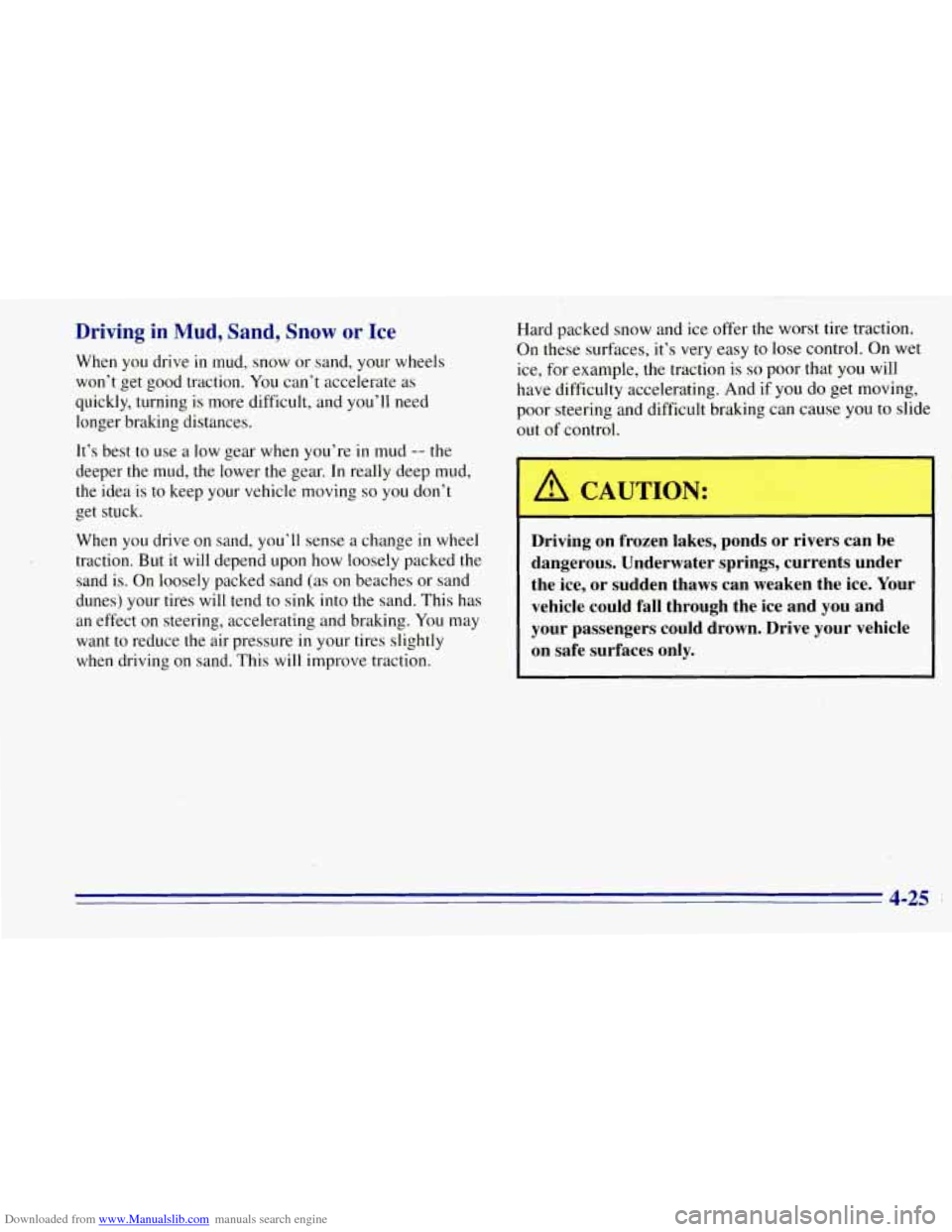
Downloaded from www.Manualslib.com manuals search engine Driving in Mud, Sand, Snow or Ice
When you drive in mud, snow or sand, your wheels
won’t.get good traction.
You can’t accelerate as
quickly, turning is more difficult, and
you’ll need
longer, braking distances.
It’s best to use a low gear when you’re
in mud -- the
deeper the mud, the lower the gear. In really deep mud,
the idea is to keep your vehicle moving
so you don’t
get stuck.
When you drive
on sand, you’ll sense a change in wheel
traction. But it
will depend upon how loosely packed the
sand is. On loosely packed sand (as
on beaches or sand
dunes) your tires will tend
to sink into the sand. This has
an effect on steering, accelerating and braking.
You may
want to reduce the air pressure in your tires slightly
when’driving on sand. This will improve traction. Hard
packed snow and ice offer the worst tire traction.
On these surfaces, it’s very easy to lose control.
On wet
ice, for example, the traction is
so poor that you will
have difficulty accelerating. And if you do get moving,
poor steering and difficult braking can cause
you to slide
out
of control.
I A CAUTION:
Driving on frozen lakes, ponds or rivers can be
dangerous. Underwater springs, currents under
the ice, or sudden thaws can weaken the ice. Your
vehicle could fall through the ice and you and
your passengers could drown. Drive your vehicle
on safe surfaces only.
Page 186 of 403
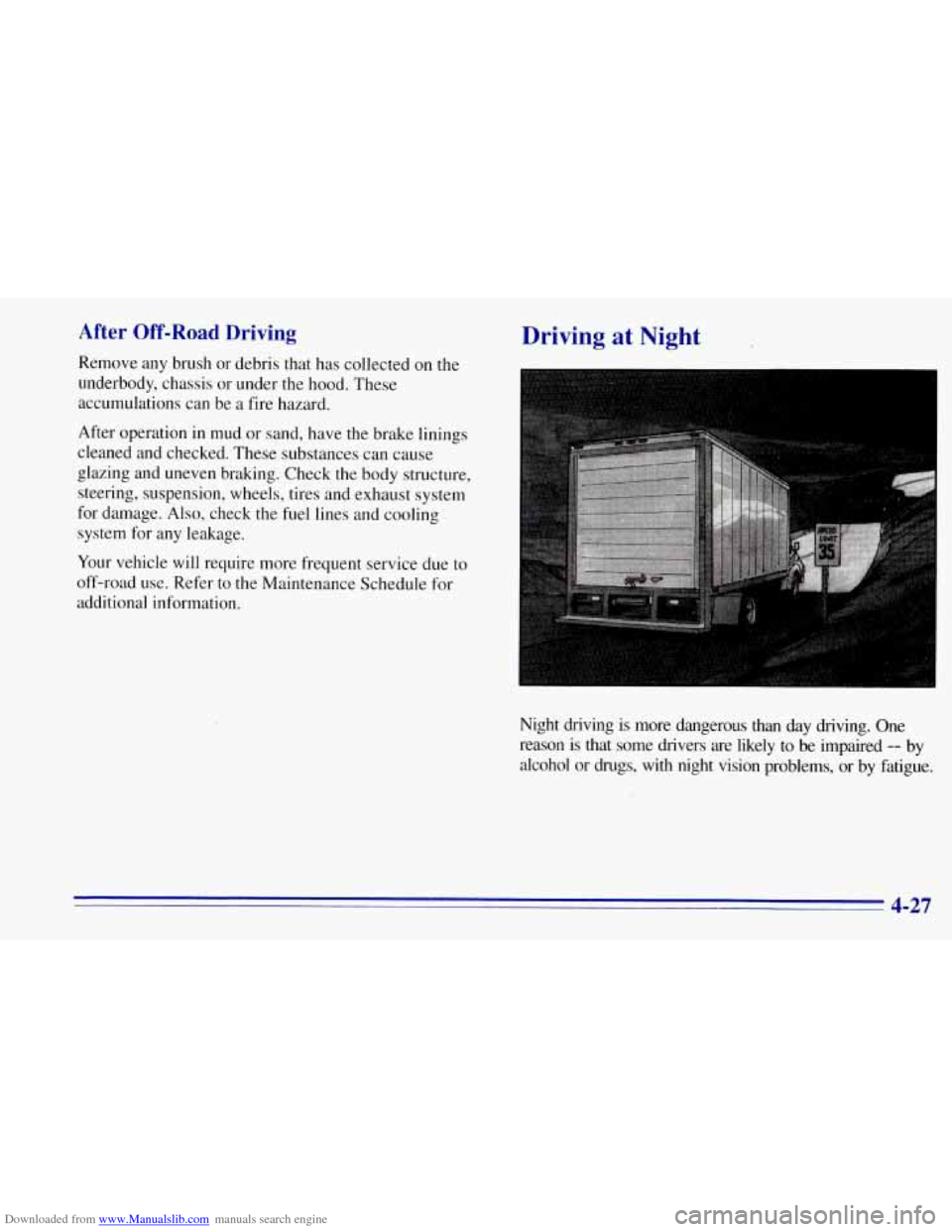
Downloaded from www.Manualslib.com manuals search engine After Off-Road Driving
Remove any brush or debris that has collected on the
underbody, chassis or under the hood. These
accumulations can be a fire hazard.
After operation in mud or sand, have the brake linings
cleaned and checked. These substances can cause
glazing and uneven braking. Check the body structure,
steering, suspension, wheels, tires and exhaust system
for damage. Also, check the fuel lines and cooling
system for any leakage.
Your vehicle will require more frequent service due to
off-road use. Refer to the Maintenance Schedule for
additional information.
Driving at Night
Night driving is more dangerous than day driving. One
reason is that some drivers are likely to be impaired
-- by
alcohol or drugs, with night vision problems, or by fatigue.
Page 198 of 403
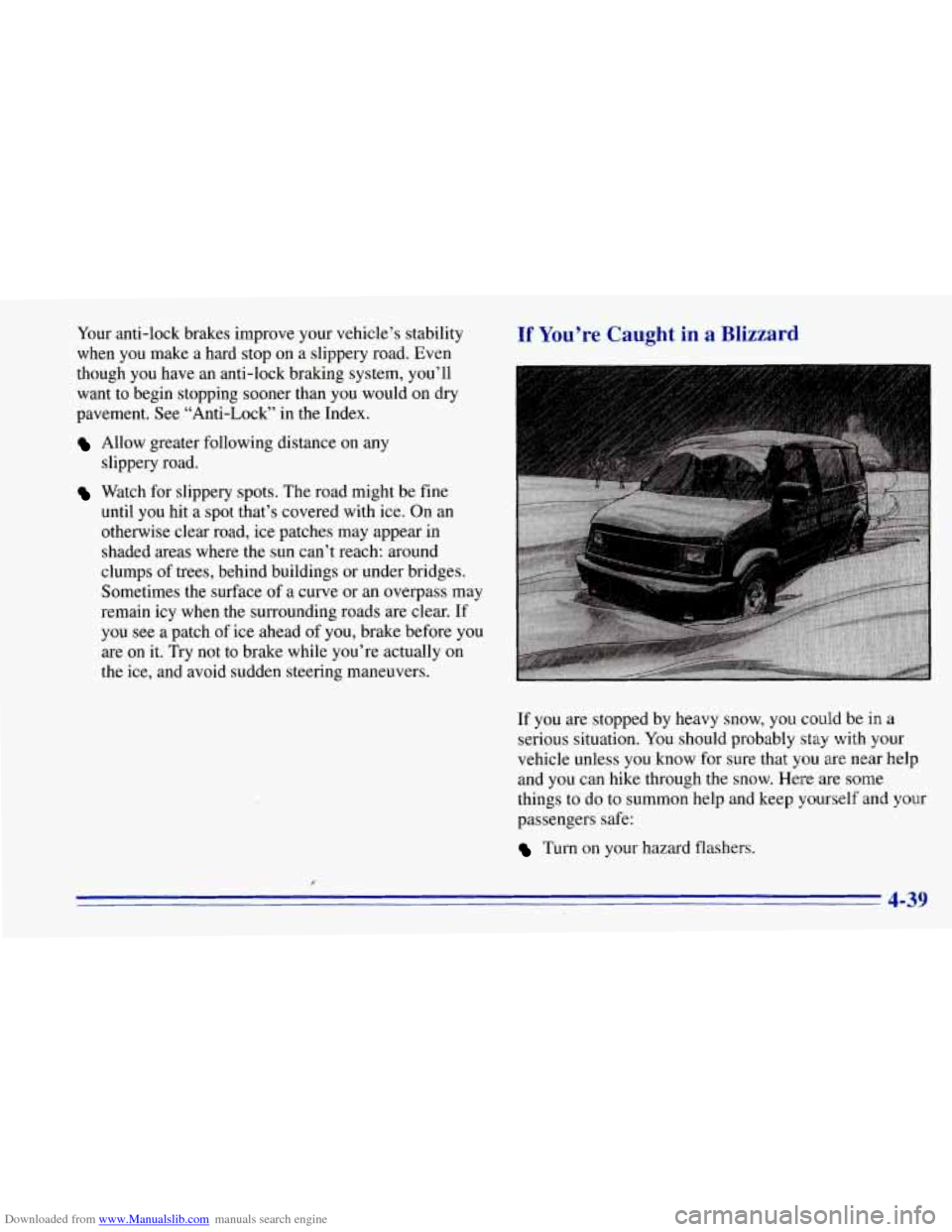
Downloaded from www.Manualslib.com manuals search engine Your anti-lock brakes improve your vehicle’s stability
when you make a hard stop on a slippery road. Even
though
you have an anti-lock braking system, you’ll
want to begin stopping sooner than you would on dry
pavement. See “Anti-Lock” in the Index.
Allow greater following distance on any
slippery road.
Watch for slippery spots. The road might be fine
until you hit a spot that’s covered with ice. On
an
otherwise clear road, ice patches may appear in
shaded areas where the sun can’t reach: around
clumps of trees, behind buildings or under bridges.
Sometimes the surface
of a curve or an overpass may
remain icy when
the surrounding roads are clear. If
you see
a patch of ice ahead of you, brake before you
are on it. Try not to brake while you’re actually on
the ice, and avoid sudden steering maneuvers.
If You’re Caught in a Blizzard
If you are stopped by heavy snow, you could be in a
serious situation.
You should probably stay with your
vehicle unless you know for sure that
you are near help
and you can hike through the snow. Here are some
things to do to summon help and keep yourself and
your
passengers safe:
Turn on your hazard flashers.
4-39
Page 209 of 403
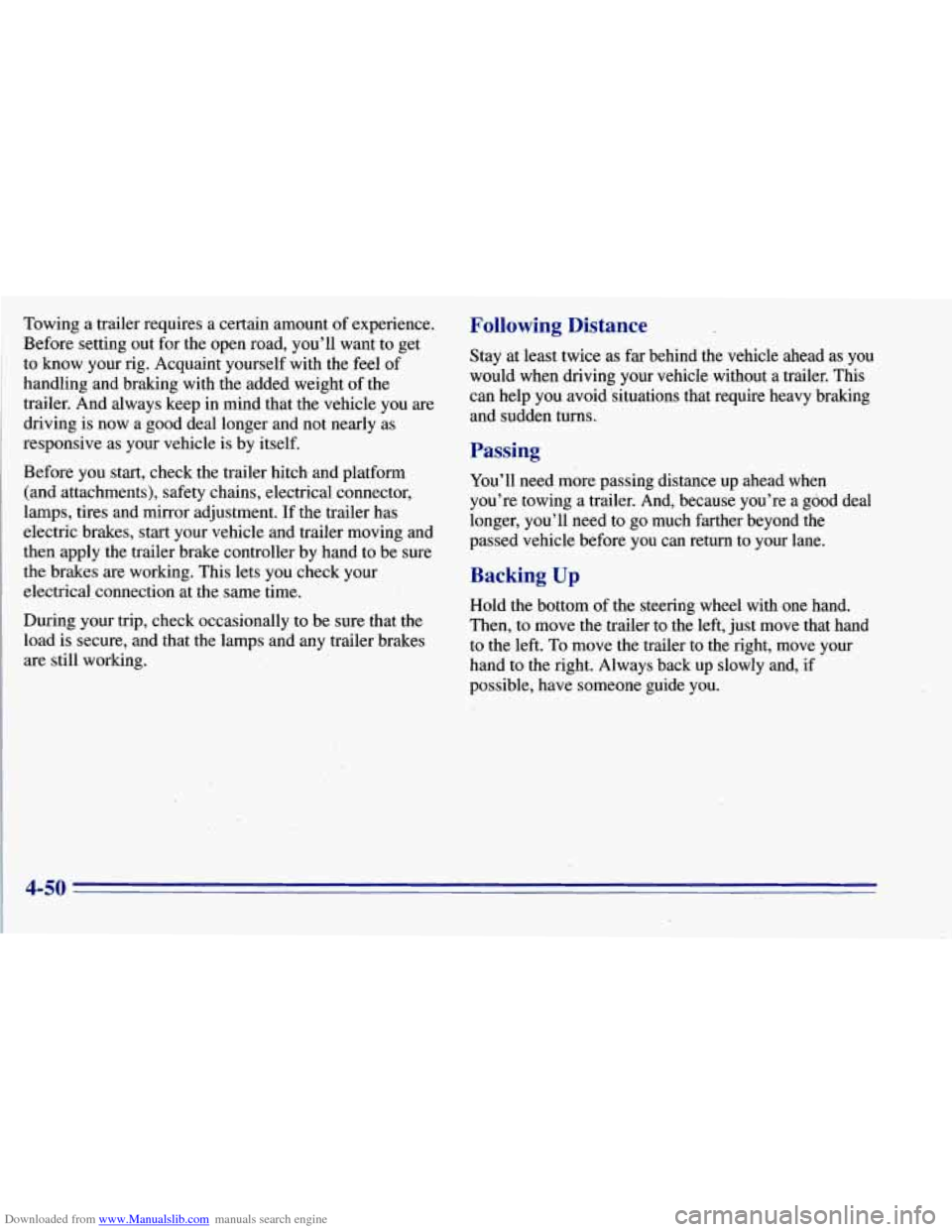
Downloaded from www.Manualslib.com manuals search engine Towing a trailer requires a certain amount of experience. Before setting out for the open road, you’ll want to get
to know.your rig. Acquaint yourself with the feel of
handling and br’aking with the,added weight of the
trailer. ‘And always keep in mind that the vehicle you are
driving
is now a good deal longer and not nearly as
responsive as your vehicle is by itself.
Before you start, check the trailer hitch- and platform (and attachments), safety chains, electrical connector,
lamps, tires and mirror adjustment. If the trailer has
electric brakes, start your vehicle and trailer moving and
then apply the trailer brake controller by hand to be sure
the brakes are working. This lets
you check your
electrical-connection
at the same time.
During your trip, check occasionally to be sure that the
load is secure, and that the lamps and any trailer brakes are still working.
Following Distance
Stay at least twice as far behind the vehicle ahead as you
would when driving your vehicle without
a trailer. This
can help you avoid situations that require heavy braking
.l
and sudden turns.
Passing
You’ll need more passing distance up ahead when you’re towing a trailer. And, because you’re a good dea
longer, you’ll need to go much farther beyond the
passed vehicle before you can return to your lane.
Backing Up
Hold the bottom of the steering wheel with one hand.
Then, to move the trailer to the left, just move that hand
to the left. To move the trailer to the right, move your
hand to the right. Always back up slowly and, if
possible, have someone guide you.
4-50
Page 216 of 403
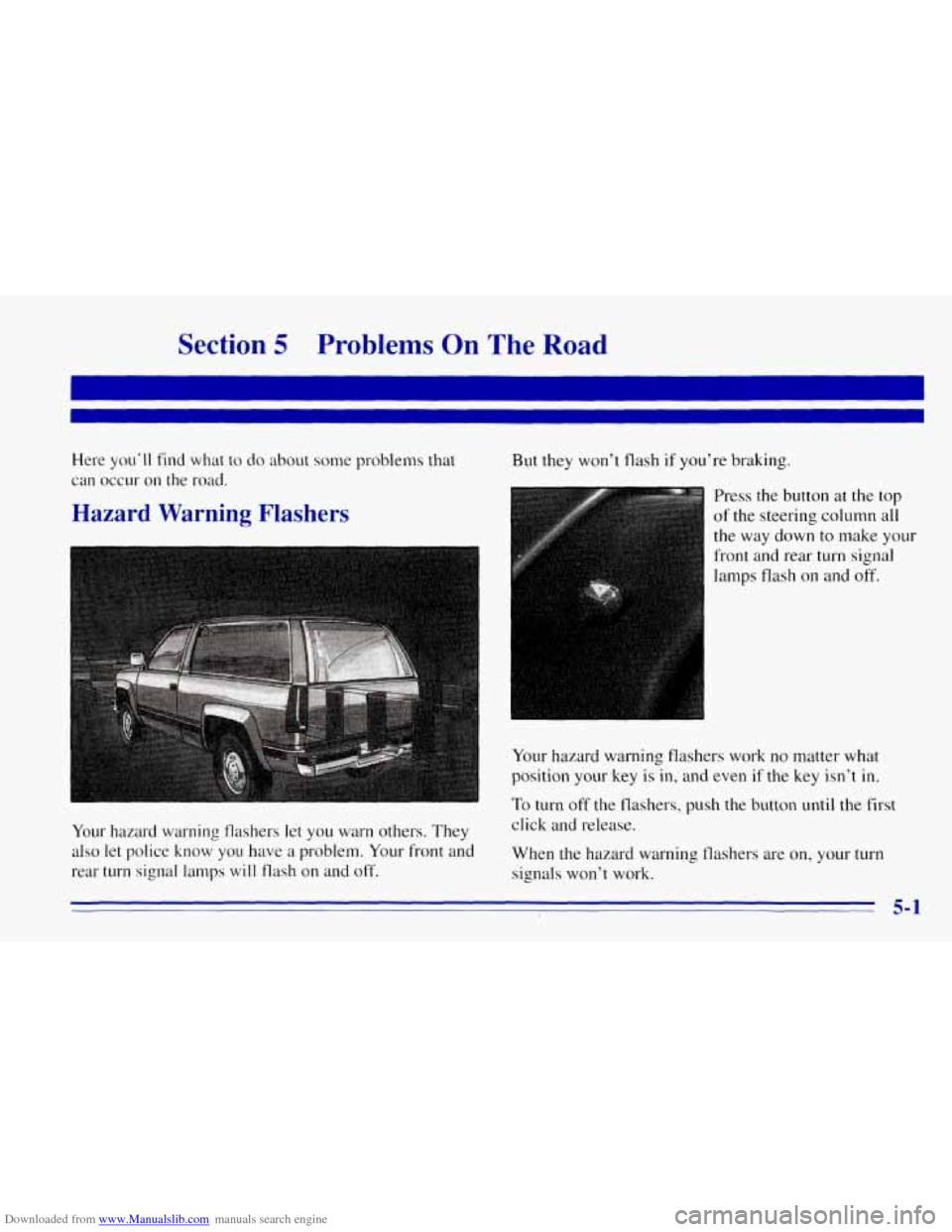
Downloaded from www.Manualslib.com manuals search engine Section 5 Problems On The Road
Here you’ll find what to do about some problems that
can occur on the road.
Hazard Warning Flashers
But they won’t flash if you’re braking.
Press the button at
the top
of the steering column all
the way down
to make your
front and rear turn signal
lamps flash
on and off.
Your hazard warning flashers work no matter what
position your key is in, and even if the key isn’t in.
To turn off the flashers, push the button until the first
Your hazard warning flashers let you warn others. They
also let police
know YOU have a problem. Your front and When the hazard warning flashers are on, your turn
rear turn signal lamps
will flash on and off. signals won’t work.
click and release.
Page 222 of 403
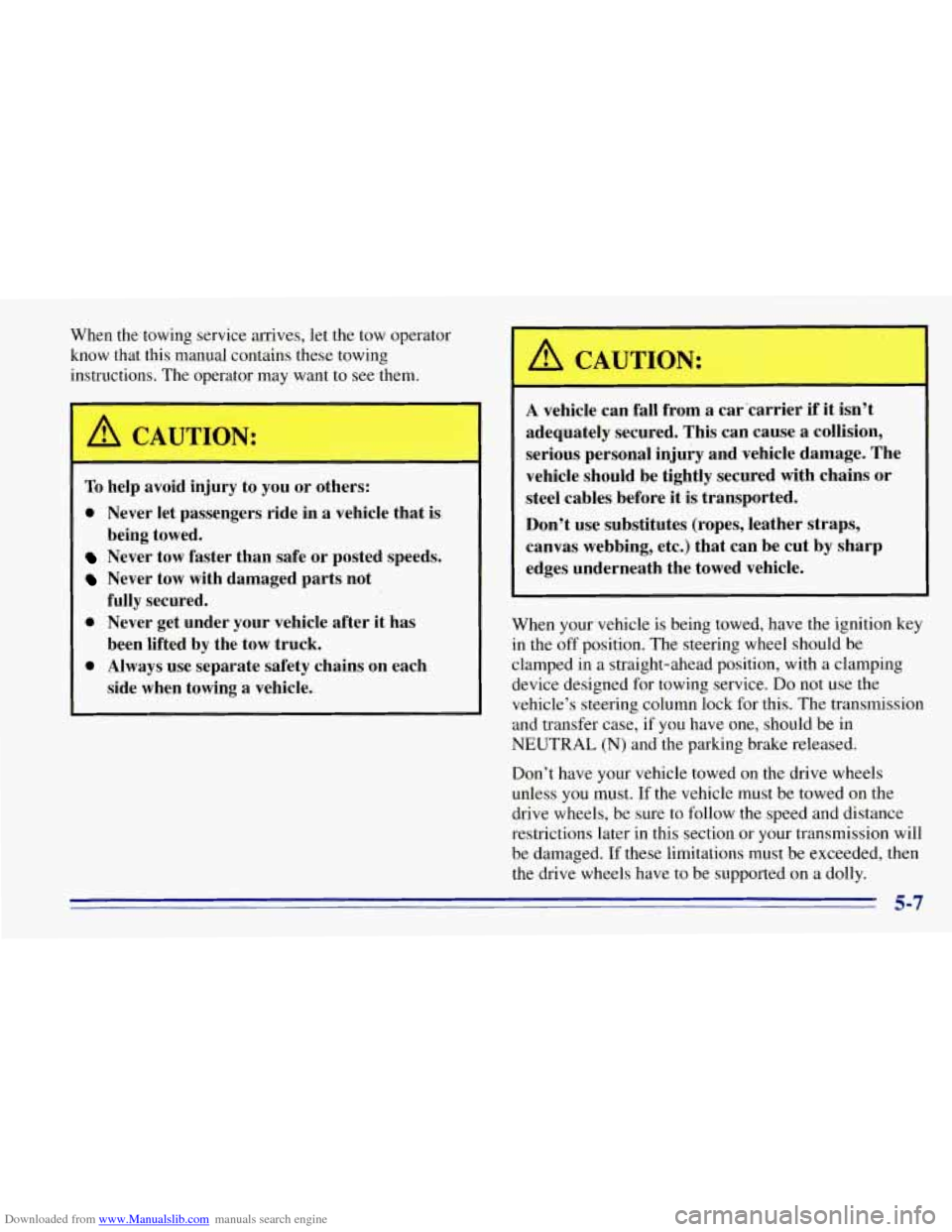
Downloaded from www.Manualslib.com manuals search engine When the towing service arrives, let the tow operator
know that this manual contains these towing
instructions. The operator may want to
see them.
I
A CAUTIO! :
To help avoid injury to you or others:
0 Never let passengers ride in a vehicle that is
Never tow faster than safe or posted speeds.
Never tow with damaged parts not
0 Never get under your vehicle after it has
0 Always use separate safety chains on each
being towed.
fully secured.
been lifted
by the tow truck.
side when towing
a vehicle.
- I
A vehicle can fall from a car’carrier if it isn’t
adequately secured. This can cause
a collision,
serious personal injury and vehicle damage. The
vehicle should be tightly secured with chains or
steel cables before it is transported.
Don’t use substitutes (ropes, leather straps,
canvas webbing, etc.) that can be cut
by sharp
edges underneath the towed vehicle.
When your vehicle is being towed, have the ignition key
in the off position. The steering wheel should be
clamped in a straight-ahead position, with
a clamping
device designed for towing service.
Do not use the
vehicle’s steering column lock for this. The transmission
and transfer case, if
you have one, should be in
NEUTRAL (N) and the parking brake released.
Don’t have your vehicle towed on the drive wheels
unless you must. If the vehicle must be towed
on the
drive wheels, be sure to follow the speed and distance
restrictions later in this section or your transmission will
be damaged. If these limitations must be exceeded, then
the drive wheels have
to be supported on a dolly.
5-7
Page 234 of 403
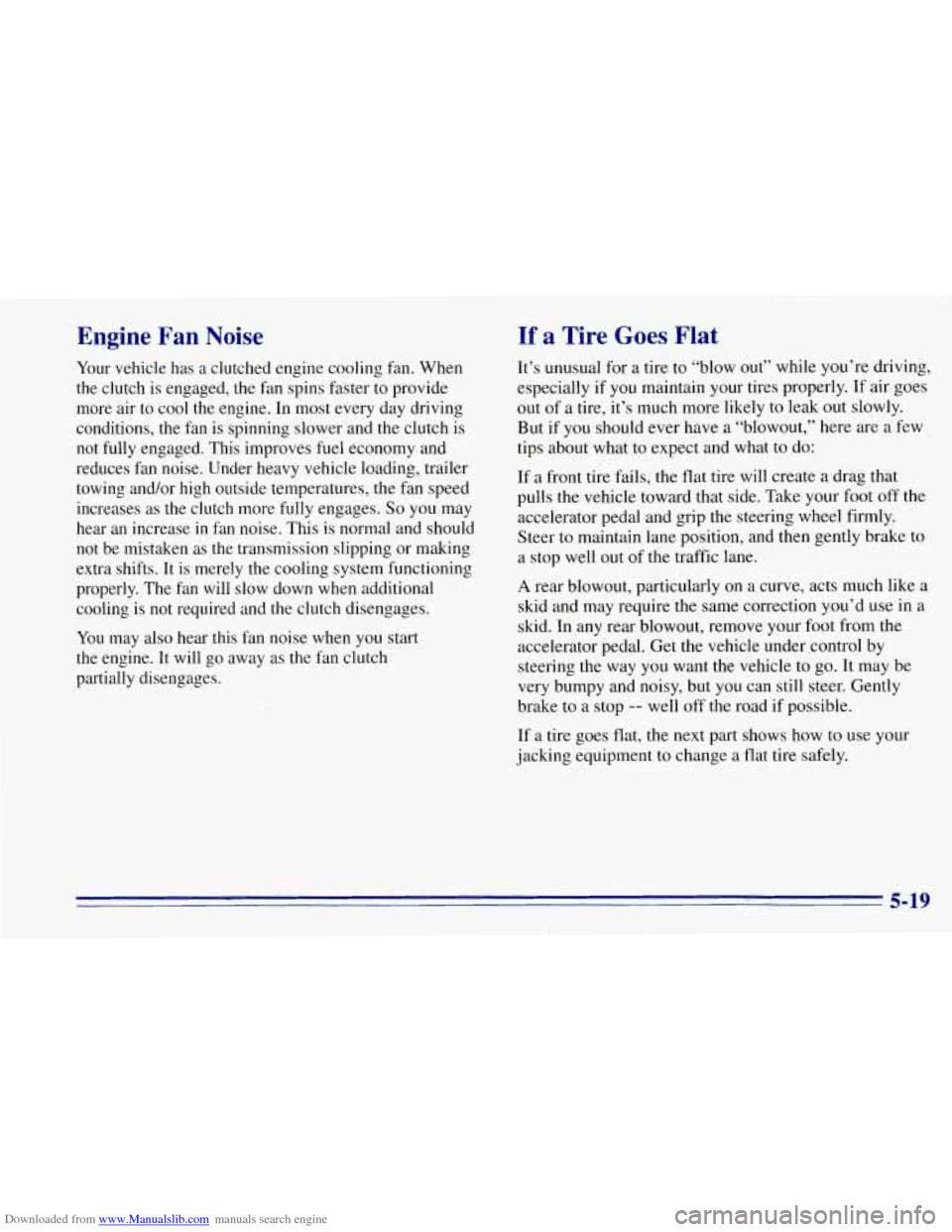
Downloaded from www.Manualslib.com manuals search engine Engine Fan Noise
Your vehicle has a clutched engine cooling fan. When
the clutch is engaged, the fan spins faster to provide
more air
to cool the engine. In most every day driving
conditions, the fan is spinning slower and the clutch
is
not fully engaged. This improves fuel economy and
reduces fan noise. Under heavy vehicle loading, trailer
towing and/or high outside temperatures, the fan speed
increases as the clutch more fully engages.
So you may
hear an increase in
fan noise. This is normal and should
not be mistaken as the transmission slipping or making
extra shifts. It is merely the cooling system functioning
properly. The fan will slow down when additional
cooling is not required and the clutch disengages.
You may also hear this fan noise when you start
the engine. It will go away as the fan clutch
partially disengages.
If a Tire Goes Flat
It’s unusual for a tire to “blow out” while you’re driving,
especially if you maintain your tires properly. If air goes
out of a tire, it’s much more likely to leak out slowly.
But if you should ever have a “blowout,” here are a few
tips about what
to expect and what to do:
If a front tire fails, the flat tire will create a drag that
pulls the vehicle toward that side. Take your foot off the
accelerator pedal and grip the steering wheel firmly.
Steer to maintain lane position, and then gently brake
to
a stop well out of the traffic lane.
A rear blowout, particularly on a curve, acts much like a
skid and may require the same correction you’d
use in a
skid. In any rear blowout, remove your foot from the
accelerator pedal. Get the vehicle under control by
steering the way
you want the vehicle to go. It may be
very bumpy and noisy, but
you can still steer. Gently
brake
to a stop -- well off the road if possible.
If a tire goes flat, the next part shows how to use your
jacking equipment to change a flat tire safely.
5-19